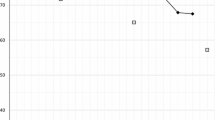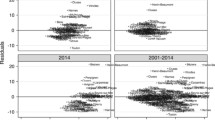Abstract
This paper investigates the relationship between economic adversity and voter participation in Turkish parliamentary elections. We employ a dynamic model of voter turnout using a cross-regional panel dataset covering all parliamentary elections for the 1987–2018 period. In addition to lagged voter turnout to account for persistency in electoral participation, our models include two measures of economic adversity: inflation, and economic growth. Empirical results indicate that inflation has a positive and significant effect on voter turnout, while economic growth is insignificant in all specifications. Moreover, inflation is associated with higher voter turnout in provinces with a denser population, higher urbanization, and more abundant human capital. Regional voter turnout rates tend to persistently support the habit formation argument. Overall, our empirical results are consistent with the mobilization hypothesis, suggesting that adverse economic conditions lead to higher electoral participation by stimulating voters to punish the government.



Similar content being viewed by others
Notes
Especially after the 1980s, Turkey has experienced a relatively high turnout rate with a national average of 86.6% in parliamentary elections. It is interesting to note that this is similar to the case of post-communist countries, where the turnout rates were quite high in the first open competitive elections (Pacek et al., 2009).
We note that, technically, the 1946 elections were the first multi-party parliamentary elections in the Republican era. However, as mentioned by Kalaycıoğlu and Çarkoğlu (2007, p.14), the 1946 elections can be regarded as a “transition election” since there were several irregularities and deficient voting practices leading to unfair elections. Sayari (2002, p.10) also mentions that the regime change was not sudden but spread over the period 1946–1950. Thus, following the common practice in related works, we take the 1950 elections as the first one in this study (also see Esmer (2002, p.1)).
See Appendix A for the NUTS classification of Turkish regions.
We cannot use the unemployment rate to measure economic fluctuations due to a lack of provincial-level data. Having said this, we believe that inflation is a much better indicator of economic adversity than the unemployment rate for several reasons. First of all, Turkey has had a chronic inflation problem since the late 1970s. The average inflation rate in the sample period, 1987–2018, was 39.2%. In this period, inflation remained in the single digits for only 12 years. In contrast, the average unemployment rate is only 8.95%. Second, the inflation volatility is much greater than the volatility in the unemployment rate. Inflation has fluctuated between 6.2% and 105%, while unemployment rate has fluctuated between 6.5% and 12.5%. In fact, the coefficient of variation of inflation and unemployment rates are 82% and 17%, respectively. Hence, Turkey has struggled with both inflation and inflation uncertainty in the last four decades. Finally, there is a dramatic variation between regional inflation rates in Turkey. The coefficient of variation of inflation varies between 82 and 118% in the sample period.
One might argue that the change from a parliamentary to a presidential system might cause a structural break and influence the estimation results. However, estimation results are robust, excluding the 2018 elections, and results are available upon request.
References
Akarca, A., & Aysit T. (2014). “Impact of internal migration on political participation in Turkey”, Turkish economic association discussion paper 2014/4, http://www.tek.org.tr/dosyalar/AKARCA&TANSEL-Participation.pdf.
Arceneaux, K. (2003). The conditional impact of blame attribution on the relationship between economic adversity and turnout. Political Research Quarterly, 56(1), 67–75.
Berdiev, A. N., & Chun-Ping, C. (2013). Explaining voter turnout in Taiwan legislative elections. International Economic Journal, 27(4), 645–661.
Blais, A., & Achen, C. H. (2010). Taking civic duty seriously: Political theory and voter turnout. Available at https://www.researchgate.net/profile/Andre-Blais-2/publication/228744422_Taking_Civic_Duty_Seriously_Political_Theory_and_Voter_Turnout/links/53d644610cf228d363ea4a87/Taking-Civic-Duty-Seriously-Political-Theory-and-Voter-Turnout.pdf. Accessed 16 Aug 2020.
Blais, A. (2000). To vote or not to vote? The merits and limits of rational choice theory. Pittsburgh, Pa: University of Pittsburgh Press.
Blais, A., & Dobrzynska, A. (1998). Turnout in electoral democracies. European Journal of Political Research, 33, 239–261.
Blais, A., & Young, R. (1999). Why do people vote? An experiment in rationality. Public Choice, 99, 39–55.
Burden, B., & Wichowsky, A. (2014). Economic discontent as a mobilizer: Unemployment and voter turnout. The Journal of Politics, 76(4), 887–898.
Cancela, J., & Geys, B. (2016). Explaining voter turnout: A meta-analysis of national and subnational elections. Electoral Studies, 42, 264–275.
Carreras, M., & Castañeda-Angarita, N. (2019). Economic adversity and electoral participation of vulnerable socioeconomic groups. Electoral Studies, 57, 110–120.
Denny, K., & Doyle, O. (2009). Does voting history matter? Analyzing persistence in turnout. American Journal of Political Science, 53(1), 17–35.
Diawakar, R. (2008). Voter turnout in the Indian states: An empirical analysis. Journal of Elections, Public Opinion and Parties, 18(1), 75–100.
Downs, A. (1957). An economic theory of democracy (pp. 260–276). New York: Harper & Row.
Esmer, Y. (2002). Introduction. In S. Sayari & Y. Esmer (Eds.), Politics, parties and elections in Turkey (pp. 1–7). Boulder, Colarado: Lynne Rienner Publishers.
Fiorino, N., Galli, E., & Pontarollo, N. (2021). Does social capital affect voter turnout? Evidence from Italy. Social Indicators Research, 156, 289–309.
Fornos, C., Power, T. J., & Garand, J. C. (2004). Explaining voter turnout in Latin America, 1980 to 2000. Comparative Political Studies, 37(8), 909–940.
Fujiwara, T., Meng, K., & Vogl, T. (2016). Habit formation in voting: Evidence from rainy elections. American Economic Journal: Applied Economics, 8(4), 160–188.
Gerber, A. S., Green, D. P., & Shachar, R. (2003). Voting may be habit-forming: Evidence from a randomized field experiment. American Journal of Political Science, 47(3), 540–550.
Geys, B. (2006). Explaining voter turnout: A review of aggregate-level research. Electoral Studies, 25, 637–663.
Gray, M., & Caul, M. (2000). Declining voter turnout in advanced industrial democracies, 1950 to 1997: The effects of declining group mobilization. Comparative Political Studies, 33(9), 1091–1122.
Grönlund, K., & Setala, M. (2007). Political trust, satisfaction and voter turnout. Comparative European Politics, 5(4), 400–422.
Jackman, R. W. (1987). Political institutions and voter turnout in the industrial democracies. The American Political Science Review, 81(2), 405–424.
Jackman, R. W., & Miller, R. A. (1995). Voter turnout in the industrial democracies during the 1980s. Comparative Political Studies, 27(4), 467–492.
Kalaycıoğlu, E., & Çarkoğlu, A. (2007). Turkish democracy today: Elections, protest and stability in an Islamic Society (1st ed.). London: I.B. Tauris and Co.
Kostadinova, T. (2003). Voter turnout dynamics in post-communist Europe. European Journal of Political Research, 42, 741–759.
Kostadinova, T., & Power, T. J. (2007). Does democratization depress participation? Voter turnout in the Latin American and eastern European transitional democracies. Political Research Quarterly, 60(3), 363–377.
Laakso, M., & Taagepera, R. (1979). The “effective” number of parties: A measure with application to west Europe. Comparative Political Studies, 12(1), 3–27.
Lim, C. (2008). Social networks and political participation: How do networks matter? Social Forces, 87(2), 961–982.
Martins, R., & Veiga, F. J. (2013). Economic performance and turnout at national and local elections. Public Choice, 157, 429–448.
Martins, R., & Veiga, F. J. (2014). Does voter turnout affect the votes for the incumbent government? European Journal of Political Economy, 36, 274–286.
Pacek, A., Pop-Eleches, G., & Tucker, J. A. (2009). Disenchanted of discerning: Voter turnout in post-communist countries. The Journal of Politics, 71(2), 473–491.
Pacek, A., & Radcliff, B. (1995). The political economy of competitive elections in the developing world. American Journal of Political Science, 39(3), 745–759.
Radcliff, B. (1992). The welfare state, turnout and the economy: A comparative analysis. American Political Science Review, 86(2), 444–454.
Riker, W., & Ordeshook, P. (1968). A Theory of the Calculus of Voting. American Political Science Review, 62(1), 25–42.
Rosenstone, S. (1982). Economic adversity and voter turnout. American Journal of Political Science, 26(1), 25–46.
Sayari, S., & Esmer, Y. (Eds.). (2002). Politics, parties and elections in Turkey. Boulder, Colorado: Lynne Rienner Publishers.
Sayari, S. (2002). The changing party system. In S. Sayari & Y. Esmer (Eds.), Politics (pp. 9–32). Boulder, Colorado: Lynne Rienner Publishers.
Stockemer, D. (2017a). What affects voter turnout? A review article/meta-analysis of aggregate research. Government and Opposition, 52(4), 698–722.
Stockemer, D. (2017b). Electoral participation: How to measure voter turnout? Social Indicators Research, 133(3), 943–962.
Sundstörm, A., & Stockemer D. (2013). “Quality of government affect voter turnout in the European regions”. Working paper series (Vol 2013, pp. 6). The Quality of Government Institute https://www.qog.pol.gu.se/digitalAssets/1443/1443756_2013_6_sundstr--m_stockemer.pdf.
Sundstörm, A., & Stockemer, D. (2015). Regional variation in voter turnout in Europe: The impact of corruption perceptions. Electoral Studies, 40, 158–169.
Van Erkel, P. F. A., & Van der Meer, T. W. G. (2015). Macroeconomic performance, political trust and the great recession: A multilevel analysis of the effects of within-country fluctuations in macroeconomic performance on political trust in 15 EU countries, 1999–2011. European Journal of Political Research, 55(1), 177–197.
Wade, L. L., Groth, A. J., & Lavelle, P. (1994). Estimating participation and party voting in Poland: The 1991 parliamentary elections. East European Politics and Societies, 8(1), 94–121.
Author information
Authors and Affiliations
Corresponding author
Additional information
Publisher's Note
Springer Nature remains neutral with regard to jurisdictional claims in published maps and institutional affiliations.
An earlier version of this paper was presented at the 2021 Meeting of the European Public Choice Society, held in Lille, France, April 21—22 2021. The authors are grateful to conference participants and anonymous referees of this journal for their helpful comments. Any remaining errors are our own.
Rights and permissions
About this article
Cite this article
Kama, Ö., Aksoy, T. & Taştan, H. Economic Adversity and Voter Turnout: Evidence from Turkish Parliamentary Elections. Soc Indic Res 163, 799–821 (2022). https://doi.org/10.1007/s11205-022-02919-4
Accepted:
Published:
Issue Date:
DOI: https://doi.org/10.1007/s11205-022-02919-4




